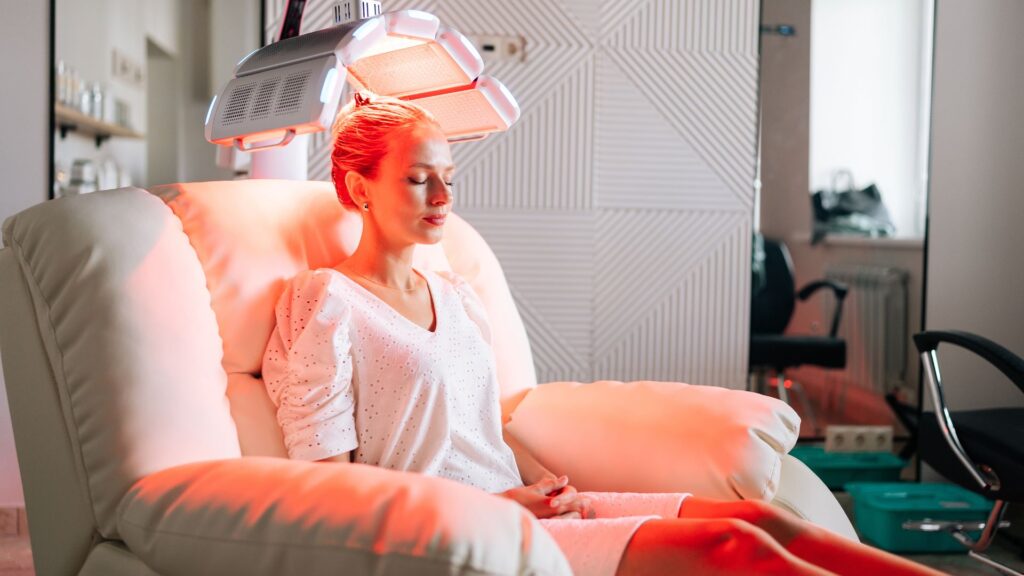Selecting the right red light therapy device involves more than just picking the first model you see on the market. With many devices offering a wide range of features, wavelengths, and applications, understanding what to look for in a red light therapy tool is essential.
This article explains the most important factors wellness professionals, med spa owners, and health providers should take into consideration, in order to make informed decisions when purchasing a light therapy product.
Understanding How a Red Light Therapy Device Works
A red light therapy device uses red and near-infrared light to stimulate cellular activity. The wavelengths, typically ranging from 600 nm to 1,000 nm, affect how deeply it penetrates the skin and tissues.
Visible red light benefits the surface, such as skin rejuvenation and collagen production, while near-infrared can reach deeper muscles and joints for pain and inflammation relief. Choosing the right wavelengths ensures that clients benefit from this therapy in the most effective way. For professional providers, advanced systems like the Light LED Bed by INNERGY Dev deliver both surface and deep-tissue results in one device.
Wavelengths and Why They Matter
Wavelength is one of the most critical factors when selecting a red light therapy device. The most effective models use specific ranges, typically around 630–660 nm for red and 810–850 nm for near-infrared. These determine how deeply energy penetrates and how effective the treatment may be.
For example, deep red light therapy is ideal for surface-level benefits like skin rejuvenation, while near infrared can reach muscles and connective tissue for recovery. A high-quality device should combine both red and NIR to maximize benefits.
Light Intensity and Treatment Time
The intensity of the light directly affects how quickly and effectively clients benefit from red light therapy. Devices use different levels of light energy, which impacts treatment time and results.
A medical-grade RLT device typically provides stronger output compared to at-home LED devices, ensuring shorter sessions and more consistent outcomes. While at-home use may appeal to some clients, professional-grade equipment ensures reliability, safety, and durability of the device, especially for businesses that require frequent use.
LED Devices vs. Laser Light Systems
When choosing the right therapy tools, it’s important to compare options between LED devices and laser light systems. LED devices are widely used due to their safety, versatility, and affordability. They deliver continuous or pulsed red light therapy, making them suitable for a range of therapy uses.
On the other hand, laser therapy devices tend to provide concentrated light that targets specific areas. Both options can be effective, but red light devices tend to offer the best options for wellness centers because they balance effectiveness with ease of use and lower risk.

FDA Clearance and Safety Standards
One of the most important considerations when purchasing a red light therapy device involves regulatory approval and safety oversight. FDA clearance means the system has been reviewed for safety and meets established wellness standards.
While red light therapy isn’t classified as a cure or medical procedure, having FDA clearance offers providers and clients added assurance that the device has passed essential checks. When comparing devices, confirm whether the equipment is cleared and review any additional safety certifications or documented testing to ensure long-term credibility and reduce liability.
At-Home vs. Professional Use
While many red light therapy devices offer benefits at home, businesses should prioritize professional-grade systems designed for consistent performance. At-home LED devices may appeal to clients who want convenience, but they often lack the intensity and durability required for commercial use.
For spas and wellness clinics, investing in high-quality equipment ensures both safety and long-term reliability. The right device also allows providers to deliver the effectiveness of red light therapy in a professional setting, increasing client trust and satisfaction.
Comparing Options and Long-Term Value
Therapy devices come in various sizes and configurations, from small red light panels to full-body beds. Devices range in cost and durability, so it’s essential to compare options based on your specific needs.
Consider factors such as the amount of light the device produces, how deeply the light can reach, and whether the device requires frequent maintenance. High-quality products not only provide the best results but also improve client retention by delivering consistent outcomes.
Final Thoughts from INNERGY Dev
Choosing a red light therapy device involves evaluating wavelengths, light intensity, FDA clearance, and whether the system suits professional or at-home use. The right device ensures your clients benefit from red light therapy with safe, effective results.
At INNERGY Dev, we specialize in providing medical-grade wellness technology designed for spas, wellness centers, and recovery practices. With decades of experience in the field, we help providers benefit from red light therapy by offering durable and effective devices that support reliable outcomes. Our expertise ensures you have access to the best equipment and guidance to confidently integrate red light therapy into your services.

